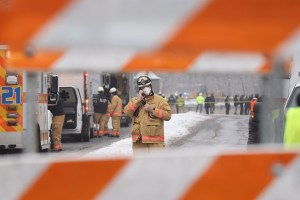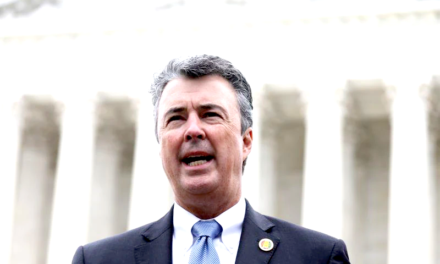by Charlie Wolfson, PublicSource via New Pittsburgh Courier
The 447-foot Forbes Avenue bridge spanning a Frick Park ravine garnered poor ratings on its condition for years. When it collapsed early Friday morning, it became a shocking punctuation point on the calls for investment into the region’s infrastructure.
“Infrastructure will continue to deteriorate and we need to put in resources to ensure things like this don’t happen,” said University of Pittsburgh engineering professor Kent Harries, citing insufficient funding for bridge maintenance nationwide.
The collapse occurred on the “major artery” just hours before President Joe Biden is slated to visit Pittsburgh to discuss the new $1.2 trillion infrastructure package, which includes funding for bridge repairs — including $1.6 billion for Pennsylvania bridges.
On a wintry morning that caused a two-hour delay for schools and others to change their morning commutes, the collapse occurred while the bridge had five cars and a county bus on it. There were no fatalities; 10 people, including some first responders, were injured, with three taken to the hospital with non-life-threatening injuries. The collapse also ruptured a gas line, which was shut off before more damage ensued.
The cause of the collapse of the Fern Hollow Bridge on Friday is under investigation. The bridge was rated “poor” by PennDOT, the state agency that inspects bridges. City officials said the bridge was most recently inspected in September 2021, but they have yet to release the inspection report to the public. A local PennDOT official declined to provide the report.
Deteriorating structures
PennDOT defines poor condition as “deterioration of primary structural elements has advanced.”
According to PennDOT records, 175 of 1,580 Allegheny County bridges are in poor condition. Of those, 29 are in Pittsburgh. Three of those 29 are owned and maintained by the state. Twenty-one of them, including the Fern Hollow Bridge, are owned and maintained by the city, meaning the city is responsible for any upgrades. (Use this PennDOT map tool to see where deficient bridges are located in the city and county.)
Pittsburgh’s $158 million 2022 capital budget contains $7.25 million for bridge upgrades.
Oxford professor Daniel Armanios, previously of Carnegie Mellon University, and CMU doctoral student Cari Gandy said Friday that Pittsburgh and area bridges need hundreds of millions of dollars to address poorly rated structures.
The two researchers said in an email to PublicSource that 12% of Pittsburgh bridges have a poorly rated component (such as the road deck, the superstructure or substructure), and they estimated $458 million is needed to improve them.
“Therefore, even just from the perspective of bridges, the recently passed $1.2 trillion infrastructure spending bill is sorely needed for both the city and the county,” they wrote.
Armanios said in an interview that the lack of available funding puts local officials in a very challenging position.
“You have 12% or more of bridges in the city in poor condition or worse. This is forcing transit officials to decide which poor bridges are repaired first,” Armanios said. “In light of funding, that might only allow you to fix a few of them or none at all.”
Safety questions
Harries said a bridge receiving a “poor” rating does not necessarily make it an imminent danger to drivers, rather that the sheer number of poorly rated bridges in the region is a symptom of our lack of funding for infrastructure maintenance. He said bridges are generally inspected and maintained properly, with bridges in the most dire need of maintenance typically receiving it. But, he said, the system is not perfect.
“ do prioritization in bridge maintenance, and sometimes bridges will jump up that list if there are issues,” he said. “Sometimes they’ll shut a bridge down within hours if they see a serious issue. But the reality is there are limited resources that limit what can be done. Most get neglected, and that is a reality that we need to deal with. The infrastructure bill makes a small dent in that.”
Harries said there can be hidden flaws that evade even the most timely inspections. “We can’t know everything about everything we build,” he said. He said a bridge of that type would be expected to last about 75 years. It was built in 1970.
The steel rigid-frame bridge that collapsed Friday received four 3-1-1 complaints for “bridge maintenance,” two in 2016 and two in 2019, according to city data.
Asked about the safety of the city’s poorly rated bridges, a city official said the matter would be addressed later Friday.
Armanios stressed infrastructure needs to be maintained constantly, not just when there is already significant deterioration.
“When there’s a collapse like today, everyone pays attention to infrastructure,” he said. “We need to pay attention to infrastructure far sooner. We need to stop taking our infrastructure for granted.”
Correction: There are 29 bridges rated “poor” in Pittsburgh, not 30 as previously stated. The story has been updated.
Charlie Wolfson is PublicSource’s local government reporter and a Report for America corps member. He can be reached at charlie@publicsource.org and on Twitter @chwolfson.
Help us Continue to tell OUR Story and join the AFRO family as a member – subscribers are now members! Join here!
The post Collapsed Pittsburgh bridge and 175 others rated poor in county drive home need for investment appeared first on AFRO American Newspapers .











